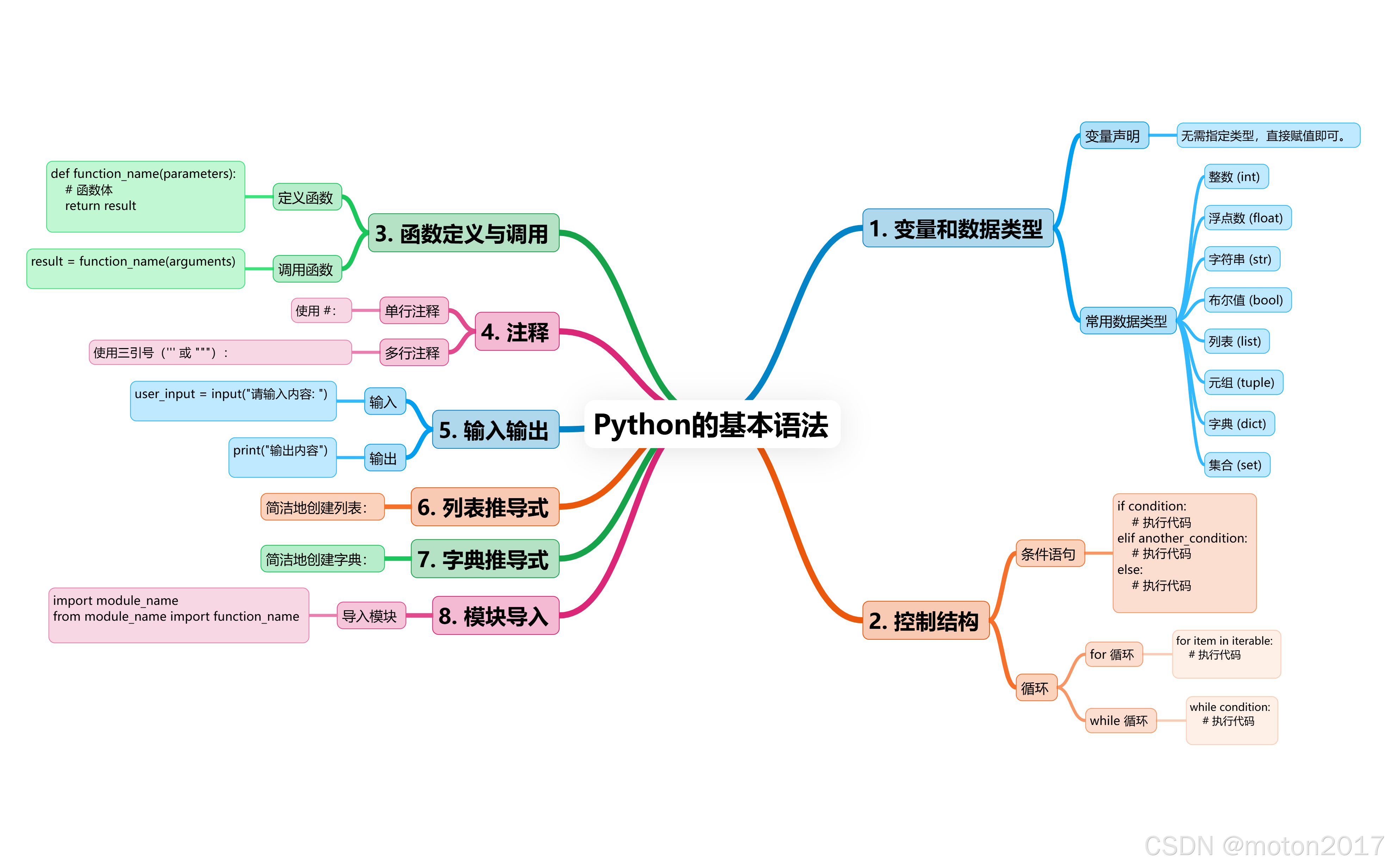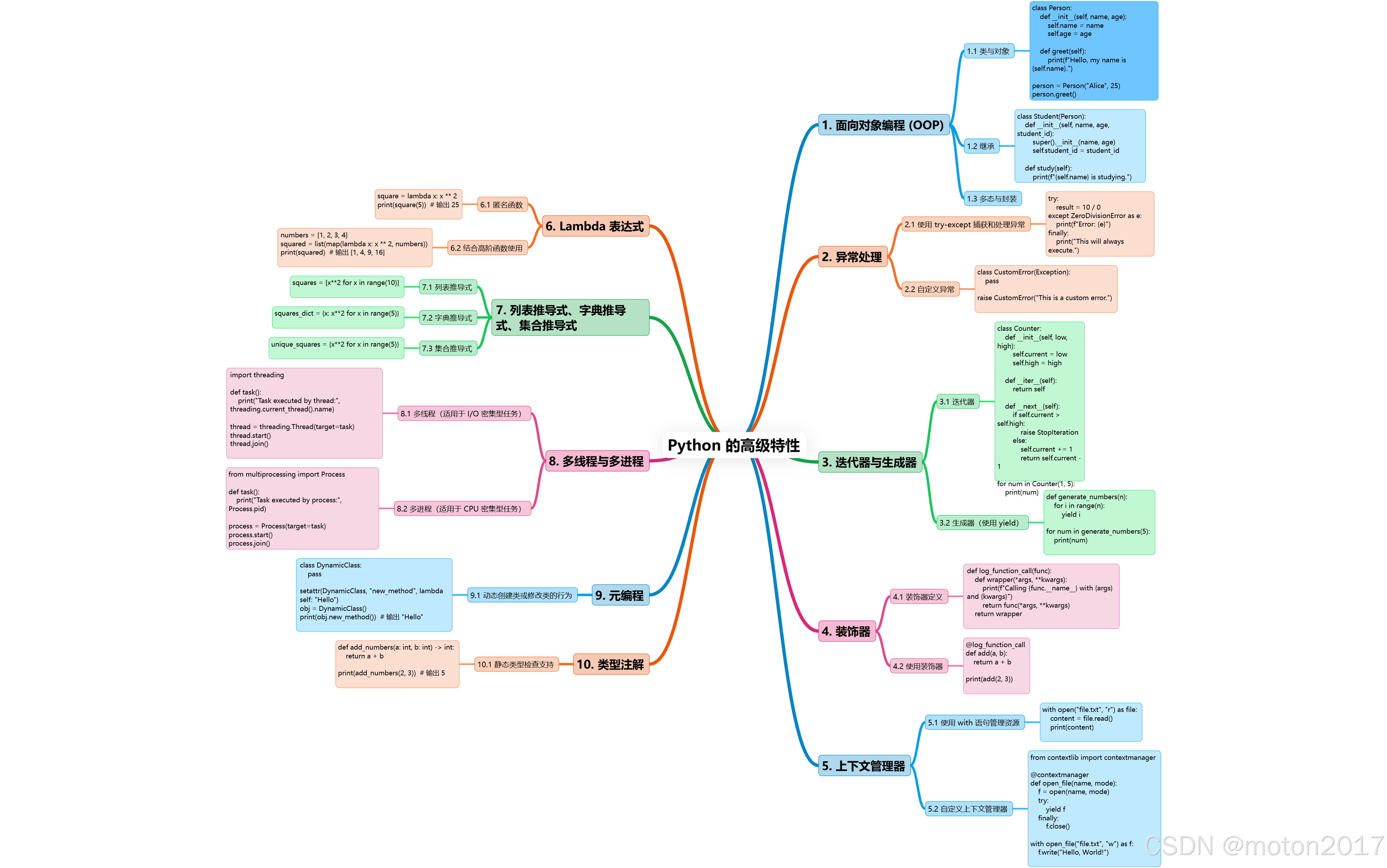扩展阅读
| Python开发者必备:语法与高级特性精讲 | Python开发者必备:语法与高级特性精讲-优快云博客 | Python的基本语法和高级属性 |
| Python 入门核心概念:语法、运算符、函数及变量类型详解 | Python 入门核心概念:语法、运算符、函数及变量类型详解-优快云博客 | Python基础知识梳理 |
| Python开发环境搭建终极指南:从零配置到高频问题解决方案 | Python开发环境搭建终极指南:从零配置到高频问题解决方案-优快云博客 | Python搭建教程及常见问题 |
| Python自动化测试框架开发指南:从模块封装到持续交付的高效实践 | Python自动化测试框架开发指南:从模块封装到持续交付的高效实践-优快云博客 | Python自动化测试框架的完整搭建指南 |
目录
1.Python的基本语法
Python的基本语法非常简洁和直观。以下是Python基本语法的关键

1. 变量和数据类型
-
变量声明:无需指定类型,直接赋值即可。
x = 5 name = "Alice" -
常用数据类型:
-
整数 (
int) -
浮点数 (
float) -
字符串 (
str) -
布尔值 (
bool) -
列表 (
list) -
元组 (
tuple) -
字典 (
dict) -
集合 (
set)
-
2. 控制结构
-
条件语句:
if condition: # 执行代码 elif another_condition: # 执行代码 else: # 执行代码 -
循环:
-
for循环:for item in iterable: # 执行代码 -
while循环:while condition: # 执行代码
-
3. 函数定义与调用
-
定义函数:
def function_name(parameters): # 函数体 return result -
调用函数:
result = function_name(arguments)
4. 注释
-
单行注释使用
#:# 这是一个注释 -
多行注释使用三引号(
'''或"""):""" 这是多行注释 可以跨越多行 """
5. 输入输出
-
输入:
user_input = input("请输入内容: ") -
输出:
print("输出内容")
6. 列表推导式
-
简洁地创建列表:
squares = [x**2 for x in range(10)]
7. 字典推导式
-
简洁地创建字典:
dict_comp = {key: value for key, value in iterable}
8. 模块导入
-
导入模块:
import module_name from module_name import function_name
2.Python 的高级特性
Python 的高级特性可以帮助开发者编写更简洁、高效和灵活的代码。以下是 Python 中一些重要的高级特性:

1. 面向对象编程 (OOP)
-
类与对象:
class Person: def __init__(self, name, age): self.name = name self.age = age def greet(self): print(f"Hello, my name is {self.name}.") person = Person("Alice", 25) person.greet() -
继承:
class Student(Person): def __init__(self, name, age, student_id): super().__init__(name, age) self.student_id = student_id def study(self): print(f"{self.name} is studying.") -
多态与封装:通过方法重写和访问控制实现。
2. 异常处理
-
使用
try-except捕获和处理异常:try: result = 10 / 0 except ZeroDivisionError as e: print(f"Error: {e}") finally: print("This will always execute.") -
自定义异常:
class CustomError(Exception): pass raise CustomError("This is a custom error.")
3. 迭代器与生成器
-
迭代器:
class Counter: def __init__(self, low, high): self.current = low self.high = high def __iter__(self): return self def __next__(self): if self.current > self.high: raise StopIteration else: self.current += 1 return self.current - 1 for num in Counter(1, 5): print(num) -
生成器(使用
yield):
def generate_numbers(n):
for i in range(n):
yield i
for num in generate_numbers(5):
print(num)4. 装饰器
-
装饰器用于扩展函数或方法的功能:
def log_function_call(func): def wrapper(*args, **kwargs): print(f"Calling {func.__name__} with {args} and {kwargs}") return func(*args, **kwargs) return wrapper @log_function_call def add(a, b): return a + b print(add(2, 3))
5. 上下文管理器
-
使用
with语句管理资源(如文件操作):with open("file.txt", "r") as file: content = file.read() print(content) -
自定义上下文管理器:
from contextlib import contextmanager @contextmanager def open_file(name, mode): f = open(name, mode) try: yield f finally: f.close() with open_file("file.txt", "w") as f: f.write("Hello, World!")
6. Lambda 表达式
-
匿名函数,常用于简化代码:
square = lambda x: x ** 2 print(square(5)) # 输出 25 -
结合高阶函数使用:
numbers = [1, 2, 3, 4] squared = list(map(lambda x: x ** 2, numbers)) print(squared) # 输出 [1, 4, 9, 16]
7. 列表推导式、字典推导式、集合推导式
-
列表推导式:
squares = [x**2 for x in range(10)] -
字典推导式:
squares_dict = {x: x**2 for x in range(5)} -
集合推导式:
unique_squares = {x**2 for x in range(5)}
8. 多线程与多进程
-
多线程(适用于 I/O 密集型任务):
import threading def task(): print("Task executed by thread:", threading.current_thread().name) thread = threading.Thread(target=task) thread.start() thread.join() -
多进程(适用于 CPU 密集型任务):
from multiprocessing import Process def task(): print("Task executed by process:", Process.pid) process = Process(target=task) process.start() process.join()
9. 元编程
-
动态创建类或修改类的行为:
class DynamicClass: pass setattr(DynamicClass, "new_method", lambda self: "Hello") obj = DynamicClass() print(obj.new_method()) # 输出 "Hello"
10. 类型注解
-
提供静态类型检查支持:
def add_numbers(a: int, b: int) -> int: return a + b print(add_numbers(2, 3)) # 输出 5
这些高级特性是 Python 编程中非常强大的工具,能够帮助编写更加优雅和高效的代码。
3.Python 的特点
- 高层次脚本语言: Python 结合了解释性、编译性、互动性和面向对象等特点。
- 可读性强: Python 的语法设计注重可读性,使用英文关键字,语法结构清晰。
- 解释型语言: Python 不需要编译,可以直接运行,类似于 PHP 和 Perl。
- 交互式语言: 可以在 Python 提示符下直接执行代码。
- 面向对象语言: 支持面向对象的编程风格。
- 适合初学者: Python 语法简单,易于学习,适合初级程序员。
- 应用广泛: 可以用于各种应用程序开发,包括文字处理、Web 开发和游戏开发。



























 被折叠的 条评论
为什么被折叠?
被折叠的 条评论
为什么被折叠?










